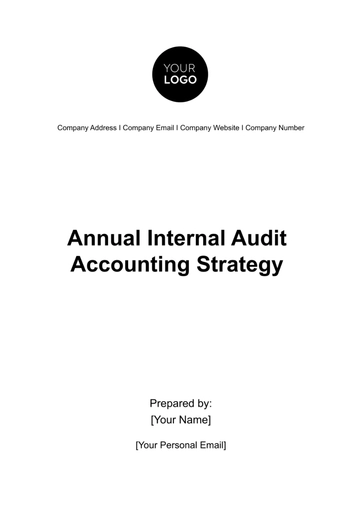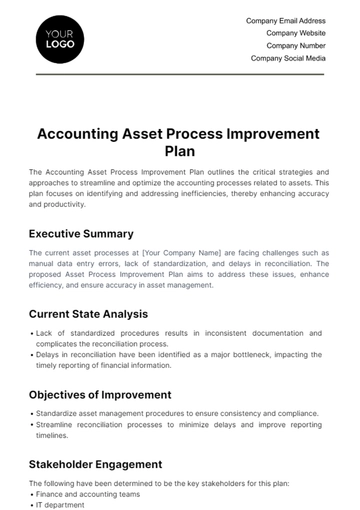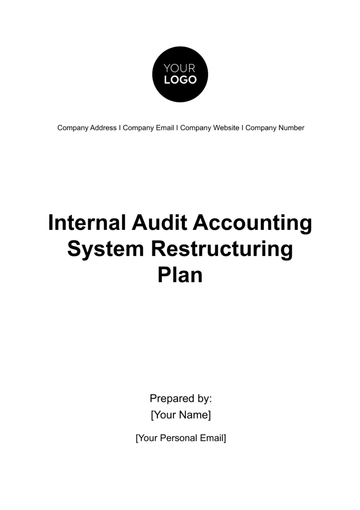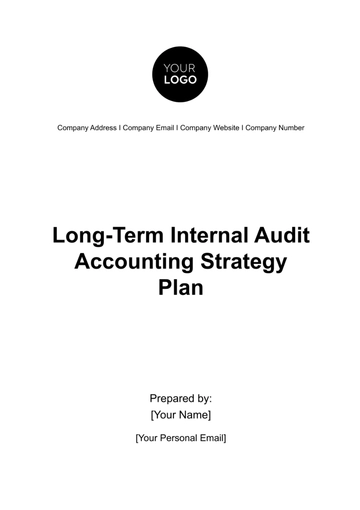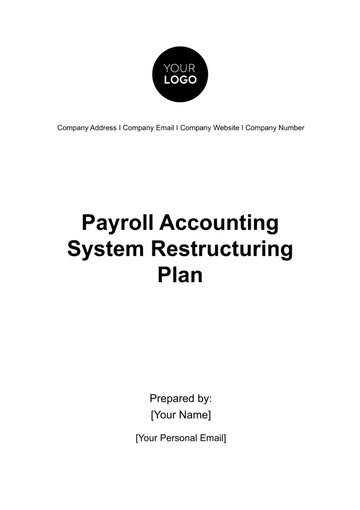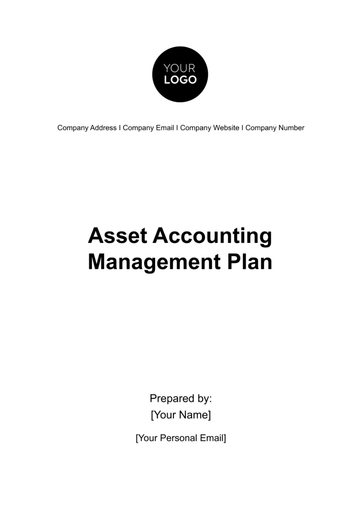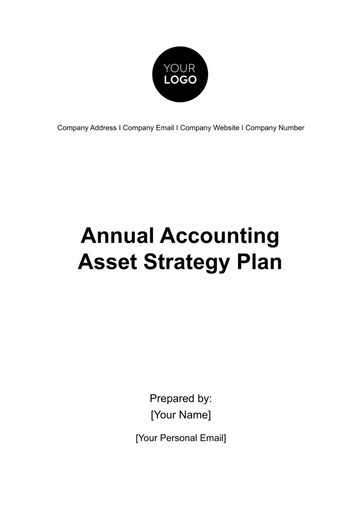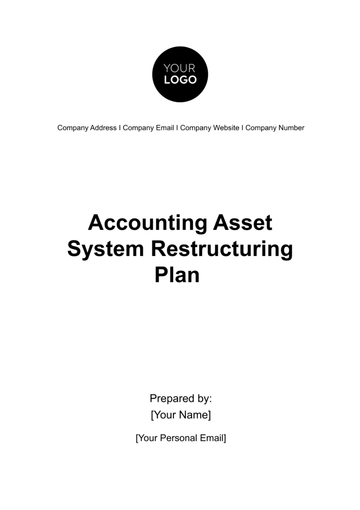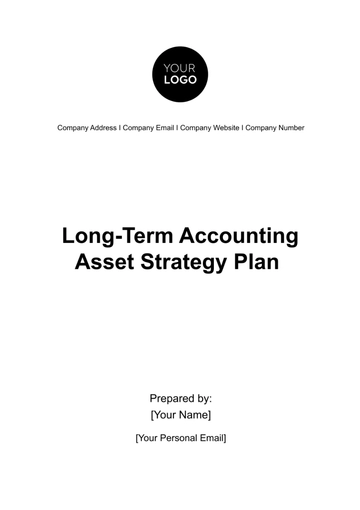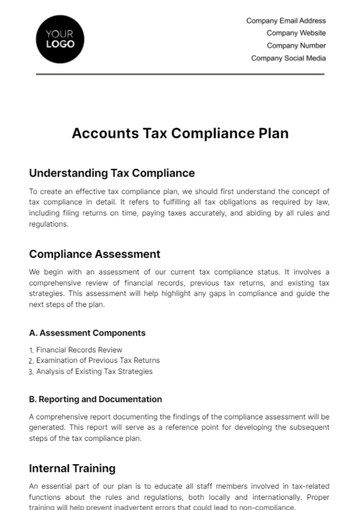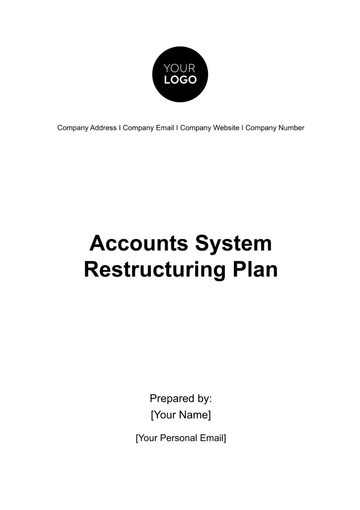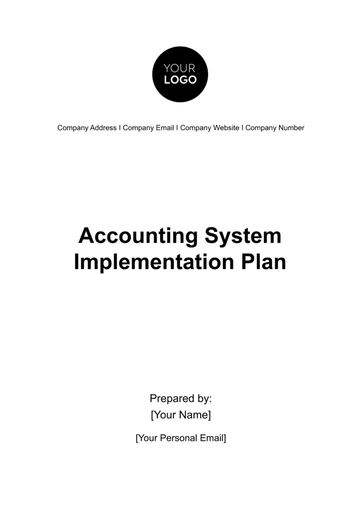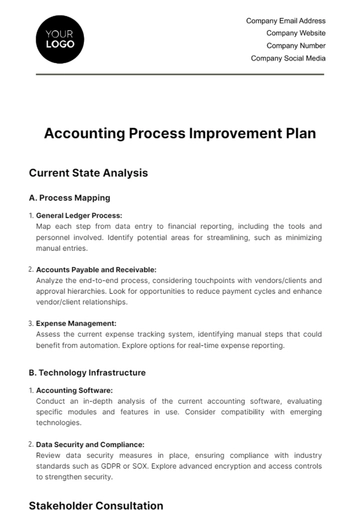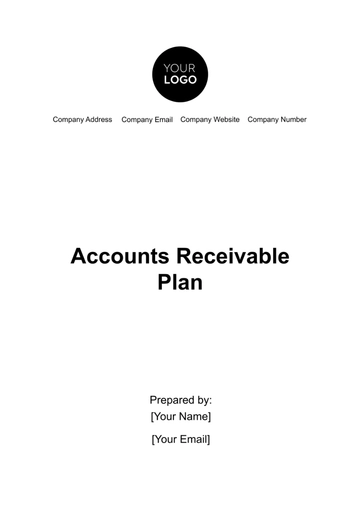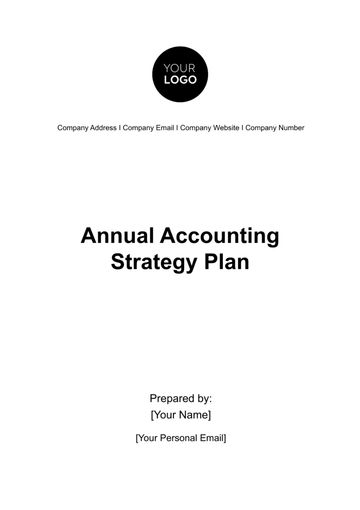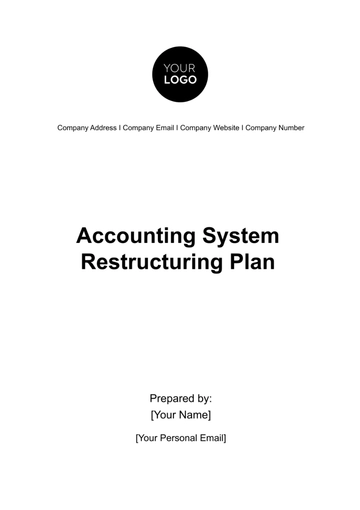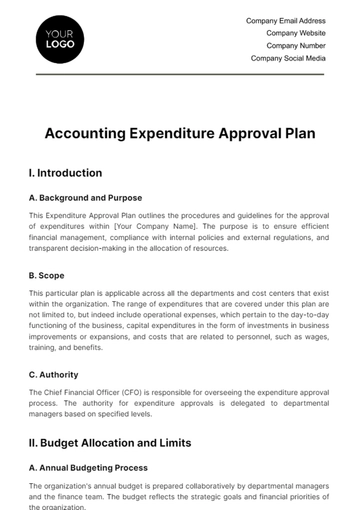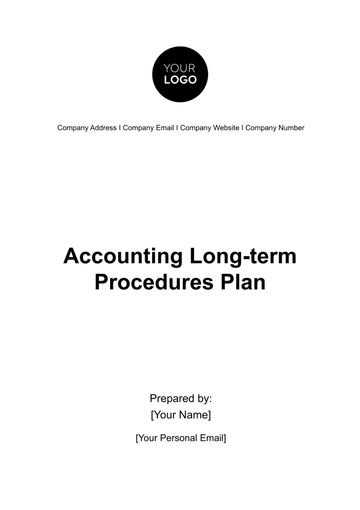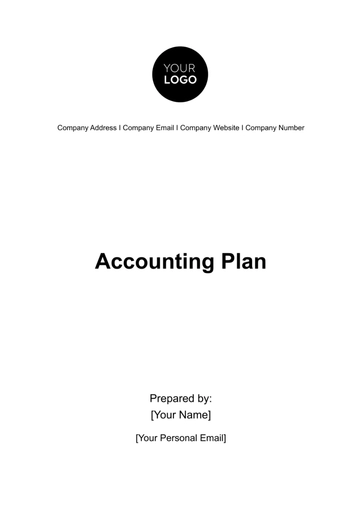Free Accounting Tax Plan

I. Introduction
An Accounting Tax Plan serves as a comprehensive framework for managing tax obligations in a manner that aligns with [Your Company Name]’s overall financial strategy. This plan is instrumental in ensuring compliance with tax laws, minimizing tax liabilities, and optimizing the company’s financial outcomes. By providing a structured approach to tax management, this plan aims to enhance [Your Company Name]'s ability to navigate complex tax regulations and make informed financial decisions.
A. Purpose of the Tax Plan
The Accounting Tax Plan is designed to achieve several key objectives:
Ensure Compliance: Adhering to all relevant tax laws and regulations is paramount to avoid legal issues and potential penalties. This includes meeting federal, state, and local tax requirements as well as adhering to international tax regulations where applicable.
Minimize Tax Liabilities: Through strategic planning and implementation of effective tax-saving measures, [Your Company Name] aims to reduce its overall tax burden. This includes leveraging tax credits, deductions, and incentives available under current tax laws.
Enhance Financial Performance: Tax planning is integrated into the company’s financial decision-making process to optimize overall performance. This involves aligning tax strategies with business objectives to improve profitability and cash flow.
Reduce Risk: By identifying and managing potential tax-related risks, [Your Company Name] can avoid unforeseen liabilities and disputes with tax authorities. Effective risk management strategies help in mitigating the risk of audits and legal challenges.
Provide Clear Guidelines: Establishing detailed procedures and responsibilities for managing tax-related activities ensures that all departments and subsidiaries within [Your Company Name] operate in a coordinated and compliant manner.
B. Scope of the Tax Plan
The scope of this tax plan is broad, covering various aspects of tax management and compliance. It includes:
Income Tax: Addresses strategies for managing federal and state income tax obligations, including planning for corporate tax and individual tax impacts.
Payroll Tax: Focuses on compliance with payroll tax regulations, including employee and employer contributions to Social Security, Medicare, and unemployment insurance.
Sales and Use Tax: Covers compliance with sales and use tax laws, including the collection and remittance of sales tax and the payment of use tax on out-of-state purchases.
Property Tax: Involves managing tax obligations related to real and personal property owned by [Your Company Name], including assessment, valuation, and payment.
International Tax: Addresses tax issues related to global operations, including transfer pricing, tax treaties, and the management of foreign tax credits and liabilities.
The plan is applicable to all divisions and subsidiaries of [Your Company Name], ensuring a cohesive approach to tax management across the organization.
C. Objectives
The primary objectives of the Accounting Tax Plan are to:
Compliance: Ensure that [Your Company Name] fully complies with all tax regulations and reporting requirements, thus avoiding any legal complications or penalties.
Tax Efficiency: Optimize tax positions through strategic planning, thereby minimizing tax liabilities and enhancing financial performance.
Risk Management: Identify and address potential tax risks, including compliance issues and audit exposure, to safeguard the company from adverse tax consequences.
Financial Optimization: Align tax strategies with broader business goals to improve profitability, cash flow, and overall financial stability.
Documentation and Reporting: Maintain accurate records and provide timely, clear reporting to tax authorities to support compliance and strategic decision-making.
II. Tax Planning Strategies
Effective tax planning involves implementing a range of strategies to manage tax obligations and optimize financial outcomes. The following sections outline key tax planning strategies for [Your Company Name]:
A. Income Tax Planning
Income tax planning involves analyzing various aspects of [Your Company Name]'s financial activities to identify opportunities for tax savings. Key strategies include:
Accelerated Depreciation: Utilizing accelerated depreciation methods, such as MACRS (Modified Accelerated Cost Recovery System), allows for a more rapid deduction of asset costs. This strategy reduces taxable income in the short term and improves cash flow by providing immediate tax benefits.
Tax Credits and Deductions: Leveraging available tax credits and deductions can significantly reduce tax liabilities. Examples include the R&D Tax Credit for innovation, energy-efficient property deductions, and various charitable contribution deductions.
Income Deferral: Deferring income to future periods, particularly if [Your Company Name] anticipates a lower tax rate in subsequent years, can help manage current-year tax liabilities. This strategy involves timing income recognition to optimize tax outcomes.
Expense Acceleration: Accelerating deductible expenses, such as prepaying certain business expenses or accelerating recognition of expenses, can reduce taxable income for the current year. This approach helps in maximizing deductions and minimizing tax liabilities.
B. Payroll Tax Management
Effective management of payroll taxes involves ensuring compliance with employment tax regulations while optimizing tax efficiency. Key strategies include:
Payroll Tax Credits: Utilizing payroll tax credits, such as the Employee Retention Credit (ERC) and the Work Opportunity Tax Credit (WOTC), can reduce payroll tax liabilities. These credits support employee retention and incentivize hiring from certain groups.
Payroll Tax Deferral: Taking advantage of government programs that allow the deferral of payroll taxes can provide temporary financial relief. This approach helps in managing cash flow during challenging periods.
Employee Benefits Optimization: Structuring employee benefits, such as offering pre-tax contributions to retirement accounts or health savings accounts (HSAs), can reduce taxable income for employees and lower payroll tax liabilities for the company.
C. Sales and Use Tax Planning
Managing sales and use tax compliance involves addressing various aspects of tax regulations and reporting requirements. Key strategies include:
Nexus Analysis: Conducting a nexus analysis helps determine where [Your Company Name] has sales tax obligations based on factors such as physical presence, economic activity, or other criteria. This analysis ensures accurate sales tax collection and remittance.
Sales Tax Exemptions: Identifying and applying for sales tax exemptions, such as resale certificates or manufacturing exemptions, can reduce sales tax liabilities. Understanding and applying these exemptions can enhance financial efficiency.
Use Tax Compliance: Ensuring accurate reporting and payment of use taxes on purchases where sales tax was not collected is crucial for compliance. Implementing procedures to track and report use tax liabilities helps prevent non-compliance.
D. Property Tax Management
Property tax management involves handling tax obligations related to real and personal property. Key strategies include:
Property Valuation Review: Regularly reviewing property valuations ensures that assessments are accurate and reflect current market values. Challenging overvalued assessments can prevent excessive property taxes.
Tax Incentives: Exploring property tax incentives offered by local governments, such as abatements, exemptions, and credits for new developments or improvements, can reduce property tax liabilities and support business growth.
Asset Reclassification: Reclassifying assets, where appropriate, can result in lower tax rates. For example, reclassifying certain assets from real property to personal property may lead to reduced tax rates and lower overall property tax obligations.
E. International Tax Considerations
Managing international tax obligations involves addressing complex issues related to global operations. Key strategies include:
Transfer Pricing: Ensuring compliance with transfer pricing regulations involves documenting intercompany transactions and pricing policies. Implementing transfer pricing strategies helps minimize global tax liabilities and avoid disputes with tax authorities.
Foreign Tax Credits: Maximizing the use of foreign tax credits helps avoid double taxation on income earned abroad. This strategy reduces the overall tax burden and improves financial outcomes for international operations.
Tax Treaties: Leveraging tax treaties between countries can reduce withholding taxes and benefit from favorable tax rates. This strategy enhances international business operations and lowers tax costs.
Repatriation Strategies: Developing strategies for repatriating foreign earnings minimizes tax impact. Utilizing participation exemptions or tax-free reorganizations can optimize repatriation and improve financial efficiency.
III. Tax Compliance Procedures
A. Tax Filing and Payment Deadlines
Adhering to tax filing and payment deadlines is critical for maintaining compliance. [Your Company Name] will follow these deadlines:
Federal Income Tax: File federal income tax returns by the 15th day of the fourth month following the end of the fiscal year. Pay estimated taxes quarterly to avoid penalties and interest.
State Income Tax: File state income tax returns according to the deadlines established by each state in which [Your Company Name] operates. Ensure compliance with state-specific requirements and payment schedules.
Payroll Taxes: Deposit payroll taxes on a semi-weekly or monthly basis, depending on the deposit schedule determined by the IRS. File Form 941 quarterly and Form W-2 annually to report wages and taxes withheld.
Sales and Use Tax: File sales and use tax returns monthly, quarterly, or annually, depending on the requirements of each jurisdiction. Ensure timely payment to avoid penalties and interest.
Property Taxes: Pay property taxes by the due dates established by local governments, typically on a semi-annual or annual basis. Accurate and timely payment is essential to prevent late fees or penalties.
B. Recordkeeping and Documentation
Maintaining thorough and accurate records is essential for supporting tax positions and ensuring compliance. [Your Company Name] will implement the following procedures:
Tax Return Documentation: Retain copies of all filed tax returns and supporting documents for a minimum of seven years. This includes both electronic and paper records for audit and review purposes.
Transaction Records: Keep detailed records of all financial transactions, including invoices, receipts, contracts, and bank statements. Organize these records to ensure easy access and retrieval for tax reporting and auditing.
Tax Planning Documentation: Document all tax planning strategies and decisions, including the rationale and expected tax benefits. This helps in justifying tax positions during audits and ensures consistency in tax planning.
C. Tax Reporting and Communication
Effective communication and reporting are crucial for maintaining transparency and ensuring compliance. [Your Company Name] will:
Internal Reporting: Provide regular updates to management on tax positions, compliance status, and any significant changes in tax laws. This includes quarterly tax updates and annual tax reviews to keep stakeholders informed and aligned with tax strategies.
External Communication: Communicate with tax authorities in a timely and accurate manner, including responding to inquiries and providing requested documentation. Ensure that all communication is documented and retained for future reference to support compliance and resolve any issues.
Tax Advisor Coordination: Collaborate with external tax advisors and consultants to stay informed about changes in tax laws and regulations. Seek professional advice on complex tax matters to ensure compliance and optimize tax strategies. Regular consultations with tax advisors help address emerging tax issues and refine tax planning strategies.
IV. Risk Management
A. Identifying Tax Risks
Effective risk management involves identifying and addressing potential tax risks that could impact [Your Company Name]. Key risks include:
Regulatory Changes: Stay informed about changes in tax laws and regulations that could affect [Your Company Name]’s tax obligations and compliance requirements. This includes monitoring legislative developments and understanding their implications on tax planning and reporting.
Audit Risks: Assess the risk of tax audits and potential issues that could arise during an audit. Implement measures to minimize audit exposure and address any potential concerns proactively. This involves maintaining accurate records, adhering to compliance requirements, and preparing for possible audit scenarios.
Compliance Risks: Identify areas where [Your Company Name] may be at risk of non-compliance, such as incorrect tax filings, missed deadlines, or improper documentation. Implement procedures to address these risks and ensure adherence to tax regulations.
B. Mitigation Strategies
To mitigate identified tax risks, [Your Company Name] will implement the following strategies:
Regular Monitoring: Continuously monitor changes in tax laws and regulations and update tax strategies and compliance procedures accordingly. This includes subscribing to tax law updates, participating in industry forums, and reviewing legal resources.
Internal Controls: Establish and maintain internal controls to ensure accurate tax reporting and compliance. This includes regular reviews of tax-related processes and procedures, as well as implementing checks and balances to detect and prevent errors.
Training and Education: Provide ongoing training and education for staff involved in tax-related activities to ensure they are knowledgeable about current tax laws and compliance requirements. Regular training sessions and updates help staff stay informed and effectively manage tax responsibilities.
Tax Advisory Services: Engage with tax advisors and consultants to address complex tax issues and obtain expert guidance on risk management strategies. Professional advice and support help in navigating intricate tax matters and mitigating potential risks.
C. Contingency Planning
Develop contingency plans to address potential tax-related issues that could arise. This includes:
Emergency Response: Establish procedures for responding to unexpected tax-related events, such as audits, legal disputes, or significant changes in tax laws. Develop a response plan to address these events and minimize their impact on the company.
Crisis Management: Implement a crisis management plan to handle high-risk situations that could impact [Your Company Name]’s tax compliance and financial stability. This involves preparing for worst-case scenarios and developing strategies to manage and recover from crises.
Recovery Plans: Develop plans for recovering from adverse tax situations, including strategies for managing financial impacts and addressing legal or regulatory issues. Create a roadmap for resolving tax-related problems and restoring normal operations.
V. Conclusion
The Accounting Tax Plan for [Your Company Name] provides a comprehensive framework for managing tax obligations effectively while optimizing financial performance. By implementing the strategies and procedures outlined in this plan, [Your Company Name] aims to achieve compliance with tax laws, minimize tax liabilities, and enhance overall financial stability.
A. Summary of Key Points
Purpose: The plan aims to ensure compliance, minimize tax liabilities, and enhance financial performance through effective tax management and strategic planning.
Scope: Covers income tax, payroll tax, sales tax, property tax, and international tax considerations, ensuring a holistic approach to tax management.
Objectives: Focuses on compliance, tax efficiency, risk management, financial optimization, and comprehensive documentation and reporting.
Strategies: Includes income tax planning, payroll tax management, sales and use tax planning, property tax management, and international tax considerations to optimize tax outcomes.
Compliance Procedures: Outlines filing deadlines, recordkeeping practices, and communication procedures to ensure adherence to tax regulations and accurate reporting.
Risk Management: Identifies tax risks, mitigation strategies, and contingency planning to address potential challenges and safeguard the company’s financial stability.
B. Next Steps
Implementation: Begin implementing the strategies and procedures outlined in this plan, ensuring all relevant departments are informed and trained. This includes assigning responsibilities, setting deadlines, and initiating the rollout of new processes.
Review and Update: Regularly review and update the tax plan to reflect changes in tax laws, regulations, and [Your Company Name]’s business operations. Conduct periodic reviews to ensure the plan remains current and effective.
Monitor and Evaluate: Continuously monitor tax compliance and financial performance, and evaluate the effectiveness of tax strategies and risk management measures. Implement metrics and feedback mechanisms to assess performance and make necessary adjustments.
- 100% Customizable, free editor
- Access 1 Million+ Templates, photo’s & graphics
- Download or share as a template
- Click and replace photos, graphics, text, backgrounds
- Resize, crop, AI write & more
- Access advanced editor
Plan and optimize your taxes efficiently with the Accounting Tax Plan Template from Template.net. This customizable template provides a comprehensive approach to tax planning, ensuring compliance and maximizing savings. Editable in our AI Editor Tool, it’s essential for managing your tax obligations effectively. Download now and prepare for tax season with confidence!
You may also like
- Finance Plan
- Construction Plan
- Sales Plan
- Development Plan
- Career Plan
- Budget Plan
- HR Plan
- Education Plan
- Transition Plan
- Work Plan
- Training Plan
- Communication Plan
- Operation Plan
- Health And Safety Plan
- Strategy Plan
- Professional Development Plan
- Advertising Plan
- Risk Management Plan
- Restaurant Plan
- School Plan
- Nursing Home Patient Care Plan
- Nursing Care Plan
- Plan Event
- Startup Plan
- Social Media Plan
- Staffing Plan
- Annual Plan
- Content Plan
- Payment Plan
- Implementation Plan
- Hotel Plan
- Workout Plan
- Accounting Plan
- Campaign Plan
- Essay Plan
- 30 60 90 Day Plan
- Research Plan
- Recruitment Plan
- 90 Day Plan
- Quarterly Plan
- Emergency Plan
- 5 Year Plan
- Gym Plan
- Personal Plan
- IT and Software Plan
- Treatment Plan
- Real Estate Plan
- Law Firm Plan
- Healthcare Plan
- Improvement Plan
- Media Plan
- 5 Year Business Plan
- Learning Plan
- Marketing Campaign Plan
- Travel Agency Plan
- Cleaning Services Plan
- Interior Design Plan
- Performance Plan
- PR Plan
- Birth Plan
- Life Plan
- SEO Plan
- Disaster Recovery Plan
- Continuity Plan
- Launch Plan
- Legal Plan
- Behavior Plan
- Performance Improvement Plan
- Salon Plan
- Security Plan
- Security Management Plan
- Employee Development Plan
- Quality Plan
- Service Improvement Plan
- Growth Plan
- Incident Response Plan
- Basketball Plan
- Emergency Action Plan
- Product Launch Plan
- Spa Plan
- Employee Training Plan
- Data Analysis Plan
- Employee Action Plan
- Territory Plan
- Audit Plan
- Classroom Plan
- Activity Plan
- Parenting Plan
- Care Plan
- Project Execution Plan
- Exercise Plan
- Internship Plan
- Software Development Plan
- Continuous Improvement Plan
- Leave Plan
- 90 Day Sales Plan
- Advertising Agency Plan
- Employee Transition Plan
- Smart Action Plan
- Workplace Safety Plan
- Behavior Change Plan
- Contingency Plan
- Continuity of Operations Plan
- Health Plan
- Quality Control Plan
- Self Plan
- Sports Development Plan
- Change Management Plan
- Ecommerce Plan
- Personal Financial Plan
- Process Improvement Plan
- 30-60-90 Day Sales Plan
- Crisis Management Plan
- Engagement Plan
- Execution Plan
- Pandemic Plan
- Quality Assurance Plan
- Service Continuity Plan
- Agile Project Plan
- Fundraising Plan
- Job Transition Plan
- Asset Maintenance Plan
- Maintenance Plan
- Software Test Plan
- Staff Training and Development Plan
- 3 Year Plan
- Brand Activation Plan
- Release Plan
- Resource Plan
- Risk Mitigation Plan
- Teacher Plan
- 30 60 90 Day Plan for New Manager
- Food Safety Plan
- Food Truck Plan
- Hiring Plan
- Quality Management Plan
- Wellness Plan
- Behavior Intervention Plan
- Bonus Plan
- Investment Plan
- Maternity Leave Plan
- Pandemic Response Plan
- Succession Planning
- Coaching Plan
- Configuration Management Plan
- Remote Work Plan
- Self Care Plan
- Teaching Plan
- 100-Day Plan
- HACCP Plan
- Student Plan
- Sustainability Plan
- 30 60 90 Day Plan for Interview
- Access Plan
- Site Specific Safety Plan


